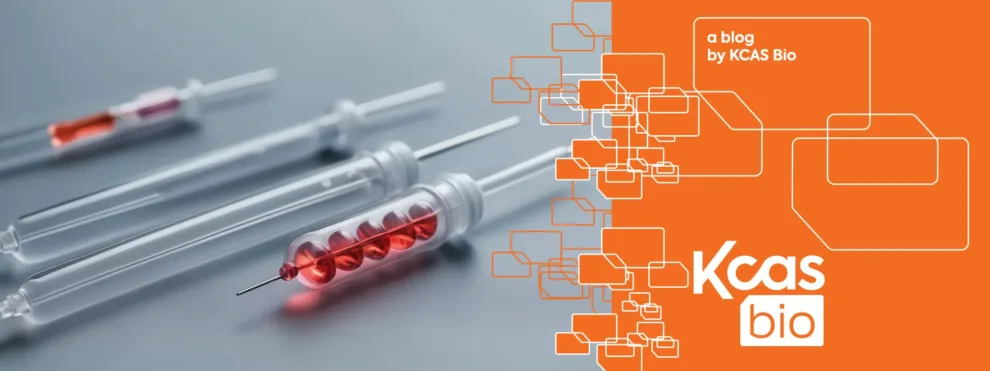At KCAS Bio, we continuously seek ways to improve our processes with sound, logical, scientific, and business-related methods. One of these areas of evaluation has been sample preparation. We have improved various segments of bioanalysis (drying for unstable analytes, liquid handling, and plate-based assays for increased efficiency). We can also consider alternative sample collection techniques for some bioanalytical assays. Let’s think about a few fundamental questions. Can we reduce sample volumes in cases where we typically request approximately 50 µL (preclinical) to 500 µL (clinical) of samples for Pharmacokinetic analysis? In the case of preclinical assays, how about the number of animals utilized for Pharmacokinetic or Toxicokinetic studies? Do we have to have the customary 3 rats or 9 mice to do a typical sparse sampling rodent study? Can we obtain a full PK profile from one animal?
What if we utilized a variety of micro-sampling techniques such as Mitra VAMS, Tasso-M20, and Dry Blood Spot (DBS) to sample an entire profile from one animal in cases where sparse sampling typically is utilized? Then more profiles could be generated with the same number of animals, capturing animal-to-animal variations. Micro-sampling has been suggested for PK or TK studies of rodents. We do not see any limitation to applying it to even larger animals (Dogs, Rabbits, NHP).
The industry has been slow to accept this technique, due to issues such as percent hematocrit. However, in the newest industry guidance published in 2022, commonly known as M10, it was stated that micro sampling may be worth re-evaluating. We have found that with some level of training, micro sampling can compare well with the traditional standard approach. KCAS Bio’s evaluation of micro-sampling devices, such Mitra VAMS and Tasso-M20, has been completed and will be forthcoming in future blogs.
In our micro-sampling work, we did not observe any strong correlation with the molecular weight or solubility of the analyte with regard to whether micro-sampling assay development could be successful. Similar acceptance criteria and reproducibility are possible when compared to the traditional blood collection, and due to sample size limitations, sub ng/mL LLoQ’s will be challenging but that is not always required. The logistics of micro-sampling are somewhat different than the traditional blood collection, but there are advantages that make it attractive as described below.
Pros of this approach for non-clinical studies:
- Less invasive.
- Eliminates the need to spin down whole blood to separate plasma. Significantly less blood is required compared to traditional plasma sampling (e.g. 50 µL vs. 5 µL).
- Total blood volume collected for ten to twelve time points in a 24-hour period can be well below the recommended safe draw volume of 7% of the total system volume for a single time point as in the traditional sparse sampling technique.
- Micro-sampling is developed with whole blood, eliminating the need for centrifugation at the collection point.
- Micro-sampling cards are stored at room temperature in desiccants and do not need refrigeration.
- Shipping micro-sampling is less expensive and easier due to lower shipping costs (not considered biological hazard), no need for dry ice, and no concern about delays in shipment (samples thawing if not replenished with dry ice). Keep in mind the stability through this process still needs to be tested and verified.
- Micro-sampling technique in mice requires a tail incision which is comparable to a finger prick in humans.
- Approximately the same method development timelines as the standard assay.
- Assay validation would require testing under the micro-sampling process but does not require -20°C or -70°C long term storage or freeze/thaw stability, hemolysis, and whole blood stability collection testing.
Cons:
- Micro-sampling and producing quality spots require training and practice.
- Fixed sample size (approximately 5 mL) presents a challenge for sub ng/mL LLoQs of some standard assays.
- Each micro-sampling spot can be sampled only once. For repeat analysis, replicates need to be collected.
- Care must be taken to ensure samples collected at the same time point have few, if any, differences, such as amount of blood delivered to each spot (needs to be bigger than the biopsy punch used)
- Hematocrit (the ratio of red blood cells volume to the total blood volume) affects blood distribution (viscosity effect) on a micro-sampling spot. Also, older blood tends to have reduced viscosity and should be considered when qualifying or validating a micro-sampling assay.
- Hematocrit is higher in capillary blood as compared to venous blood. This would need to be tested like matrix effect.
- For large sample size, automation may present a new challenge but not necessarily impractical.

